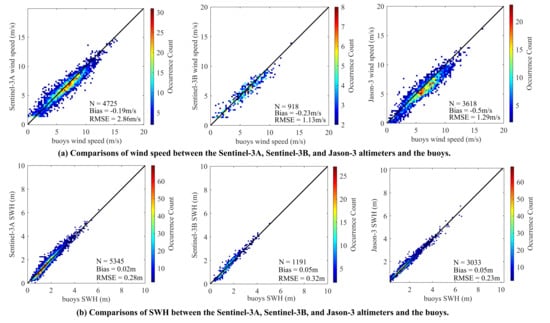Validation of Sentinel-3A/3B and Jason-3 Altimeter Wind Speeds and Significant Wave Heights Using Buoy and ASCAT Data
Abstract
1. Introduction
2. Material and Methods
2.1. Data
2.1.1. Altimeter Data
2.1.2. Buoy Data
2.1.3. Advanced Scatterometer (ASCAT) Data
2.2. Methods
3. Results and Discussion
3.1. Wind Speed Validation Using Moored Buoys Data
3.2. Wind Speed Validation by ASCAT Wind Data
3.3. Significant Wave Height Validation Using National Data Buoy Center (NDBC) Buoy Data
4. Conclusions
Author Contributions
Funding
Acknowledgments
Conflicts of Interest
References
- Nezhad, M.M.; Groppi, D.; Marzialetti, P.; Fusilli, L.; Laneve, G.; Cumo, F.; Garcia, D.A. Wind energy potential analysis using Sentinel-1 satellite: A review and a case study on Mediterranean islands. Renew. Sustain. Energy Rev. 2019, 109, 499–513. [Google Scholar] [CrossRef]
- Fu, L.L.; Chelton, D.B.; Zlotnicki, V. Satellite altimetry: Observing ocean variability from space. Oceanography 1988, 1, 4–11. [Google Scholar] [CrossRef]
- Fu, L.L.; Cazenave, A. Satellite Altimetry and Earth Sciences: A Handbook of Techniques and Applications; Academic Press: San Diego, CA, USA, 2001; pp. 95–99. [Google Scholar]
- Pires, N.; Fernandes, M.J.; Gommenginer, C.; Scharroo, R. Improved sea state bias estimation for altimeter reference missions with altimeter-only three-parameter models. IEEE Trans. Geosci. Remote Sens. 2018, 57, 1–15. [Google Scholar] [CrossRef]
- Reale, F.; Dentale, F.; Carratelli, E.P.; Fenoglio-Marc, L. Influence of sea state on sea surface height oscillation from doppler altimeter measurements in the North Sea. Remote Sens. 2018, 10, 1100. [Google Scholar] [CrossRef]
- Gommenginger, C.P.; Srokosz, M.A.; Challenor, P.G.; Cotton, P.D. Development and validation of altimeter wind speed algorithms using an extended collocated buoy/Topex dataset. IEEE Trans. Geosci. Remote Sens. 2002, 40, 251–260. [Google Scholar] [CrossRef]
- Monaldo, F. Expected differences between buoy and radar altimeter estimates of wind speed and significant wave height and their implications on buoy-altimeter comparisons. J. Geophys. Res. 1988, 93, 2285–2302. [Google Scholar] [CrossRef]
- Carter, D.J.T.; Challenor, P.G.; Srokosz, M.A. An assessment of Geosat wave height and wind speed measurements. J. Geophys. Res. 1992, 97, 11383–11392. [Google Scholar] [CrossRef]
- Gower, J.F.R. Intercalibration of wave and wind data from TOPEX/POSEIDON and moored buoys off the west coast of Canada. J. Geophys. Res. 1996, 101, 3817–3829. [Google Scholar] [CrossRef]
- Kshatriya, J.; Sarkar, A.; Kumar, R. Comparison of TOPEX/POSEIDON altimeter derived wind speed and wave parameters with ocean buoy data in the north Indian Ocean. Mar. Geod. 2001, 24, 131–138. [Google Scholar] [CrossRef]
- Dobson, E.; Monaldo, F.; Goldhirsh, J.; Wilkerson, J. Validation of Geosat altimeter-derived wind speeds and significant wave heights using buoy data. J. Geophys. Res. 1987, 92, 10719–10731. [Google Scholar] [CrossRef]
- Kumar, U.M.; Swain, D.; Sasamal, S.K.; Reddy, N.N.; Ramanjappa, T. Validation of SARAL/AltiKa significant wave height and wind speed observations over the North Indian Ocean. J. Atmos. Sol. Terr. Phys. 2015, 135, 174–180. [Google Scholar] [CrossRef]
- Ebuchi, N.; Kawamura, H. Validation of wind speeds and significant wave heights observed by the TOPEX altimeter around Japan. J. Oceanogr. 1994, 50, 479–487. [Google Scholar] [CrossRef]
- Queffeulou, P. Validation of ENVISAT RA-2 and JASON-1 altimeter wind and wave measurements. Proc. IEEE Geosci. Remote Sens. Symp. 2003, 5, 2987–2989. [Google Scholar]
- Young, I.R. An intercomparison of GEOSAT, TOPEX and ERS1 measurements of wind speed and wave height. Ocean Eng. 1998, 26, 67–81. [Google Scholar] [CrossRef]
- Abdalla, S.; Dinardo, S.; Benveniste, J.; Janssen, P.A.E.M. Assessment of CryoSat-2 SAR mode wind and wave data. Adv. Space Res. 2018, 62, 1421–1433. [Google Scholar] [CrossRef]
- Young, I.R.; Sanina, E.; Babanin, A.V. Calibration and cross validation of a global wind and wave database of altimeter, radiometer, and scatterometer measurements. J. Atmos. Ocean. Technol. 2017, 34, 1285–1306. [Google Scholar] [CrossRef]
- Ribal, A.; Young, I.R. Calibration and cross validation of global ocean wind speed based on scatterometer observations. J. Atmos. Ocean. Technol. 2020, 37, 279–297. [Google Scholar] [CrossRef]
- Ribal, A.; Young, I.R. 33 years of globally calibrated wave height and wind speed data based on altimeter observations. Sci. Data 2019, 6, 77. [Google Scholar] [CrossRef]
- Cotton, P.D.; Challenor, P.G.; Lefevre, J.-M. Calibration of Envisat and ERS-2 wind and wave data through comparisons with in-situ data and wave model analysis fields. In Proceedings of the 2004 Envisat & ERS Symposium (ESA SP-572), Salzburg, Austria, 6–10 September 2004. [Google Scholar]
- Queffeulou, P. Long-term validation of wave height measurements from altimeters. Mar. Geod. 2004, 27, 495–510. [Google Scholar] [CrossRef]
- Durrant, T.H.; Greenslade, D.J.M.; Simmonds, I. Validation of Jason-1 and Envisat remotely sensed wave heights. J. Atmos. Ocean. Technol. 2009, 26, 123–134. [Google Scholar] [CrossRef]
- Ray, R.D.; Beckley, B.D. Calibration of ocean wave measurements by the TOPEX, Jason-1, and Jason-2 satellites. Mar. Geod. 2012, 35, 238–257. [Google Scholar] [CrossRef]
- Passaro, M.; Fenoglio-Marc, L.; Cipollini, P. Validation of significant wave height from improved satellite altimetry in the German Bight. IEEE Trans. Geosci. Remote Sens. 2015, 53, 2146–2156. [Google Scholar] [CrossRef]
- Donlon, C.; Berruti, B.; Buongiorno, A.; Ferreira, M.H.; Femenias, P.; Frerick, J.; Goryl, P.; Klein, U.; Laur, H.; Mavrocordatos, C.; et al. The Global Monitoring for Environment and Security (GMES) Sentinel-3 mission. Remote Sens. Environ. 2012, 120, 37–57. [Google Scholar] [CrossRef]
- Abdalla, S. Ku-band radar altimeter surface wind speed algorithm. Mar. Geod. 2012, 35, 276–298. [Google Scholar] [CrossRef]
- Yang, J.; Zhang, J.; Wang, C. Sentinel-3A SRAL global statistical assessment and cross-calibration with Jason-3. Remote Sens. 2019, 11, 1573. [Google Scholar] [CrossRef]
- Handoko, E.Y.; Fernandes, M.J.; Lázaro, C. Assessment of altimetric range and geophysical corrections and mean sea surface models—Impacts on sea level variability around the Indonesian Seas. Remote Sens. 2017, 9, 102. [Google Scholar] [CrossRef]
- Gourrion, J.; Vandemark, D.; Bailey, S.; Chapron, B.; Gommenginger, G.P.; Challenor, P.G.; Srokosz, M.A. A two-parameter wind speed algorithm for Ku-band altimeters. J. Atmos. Oceanic Technol. 2002, 19, 2030–2048. [Google Scholar] [CrossRef]
- Collard, F. Algorithmes de Vent et P´eriode Moyenne des Vagues JASON a´ Base de Re´seaux de Neurons. BO-021-CLS-0407-RF; Boost Technologies: Plouzane´, France, 2005. [Google Scholar]
- Yang, J.G.; Zhang, J. Validation of Sentinel-3A/3B satellite altimetry wave heights with buoy and Jason-3 data. Sensors 2019, 19, 2914. [Google Scholar] [CrossRef]
- Liu, W.T.; Katsaros, K.B.; Businger, J.A. Bulk parameterization of air-sea exchanges of heat and water vapor including the molecular constraints at the interface. J. Atmos. Sci. 1979, 36, 1722–1735. [Google Scholar] [CrossRef]
- Liu, W.T.; Tang, W.Q. Equivalent Neutral Wind. Jet Propulsion Laboratory Publication 96-17. 1996. Available online: https://ntrs.nasa.gov/archive/nasa/casi.ntrs.nasa.gov/19970010322.pdf (accessed on 10 March 2020).
- Fairall, C.W.; Bradley, E.F.; Hare, J.E.; Grachev, A.A.; Edson, J.B. Bulk parameterization of air–sea fluxes: Updates and verification for the COARE algorithm. J. Clim. 2003, 16, 571–591. [Google Scholar] [CrossRef]
- Yang, J.G.; Zhang, J. Evaluation of ISS-RapidScat wind vectors using buoys and ASCAT data. Remote Sens. 2018, 10, 648. [Google Scholar] [CrossRef]
- Moreau, T.; Tran, N.; Aublanc, J.; Tison, C.; Le Gac, S.; Boy, F. Impact of long ocean waves on wave height retrieval from SAR altimetry data. Adv. Space Res. 2018, 62, 1434–1444. [Google Scholar] [CrossRef]
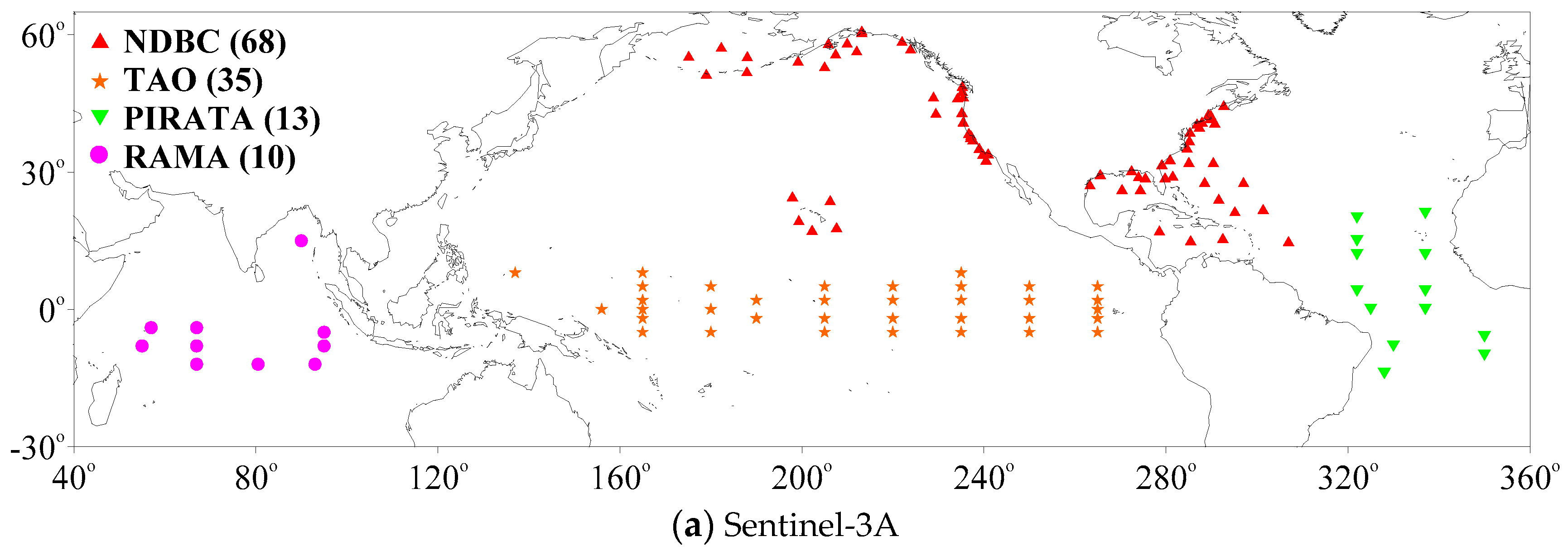
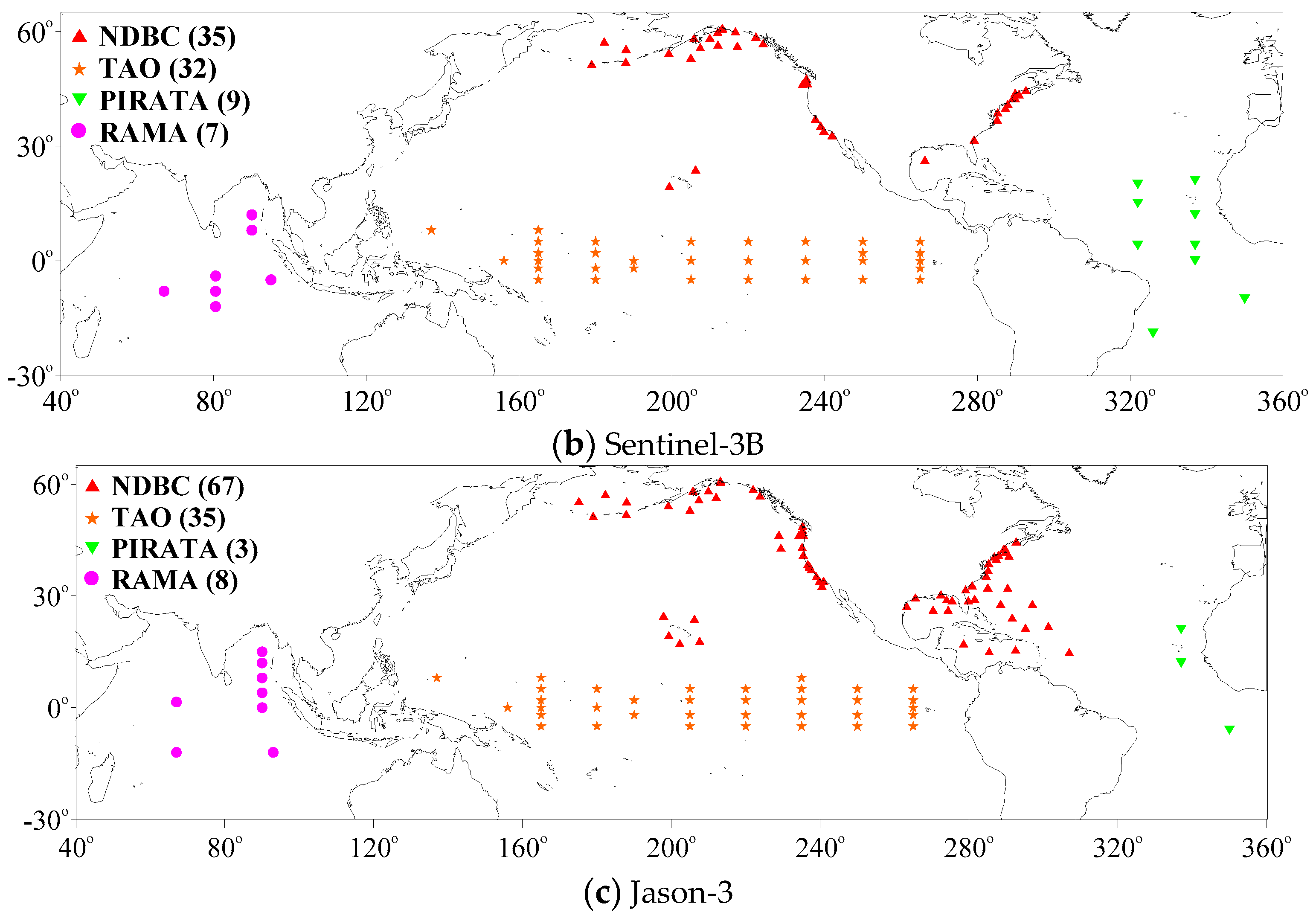
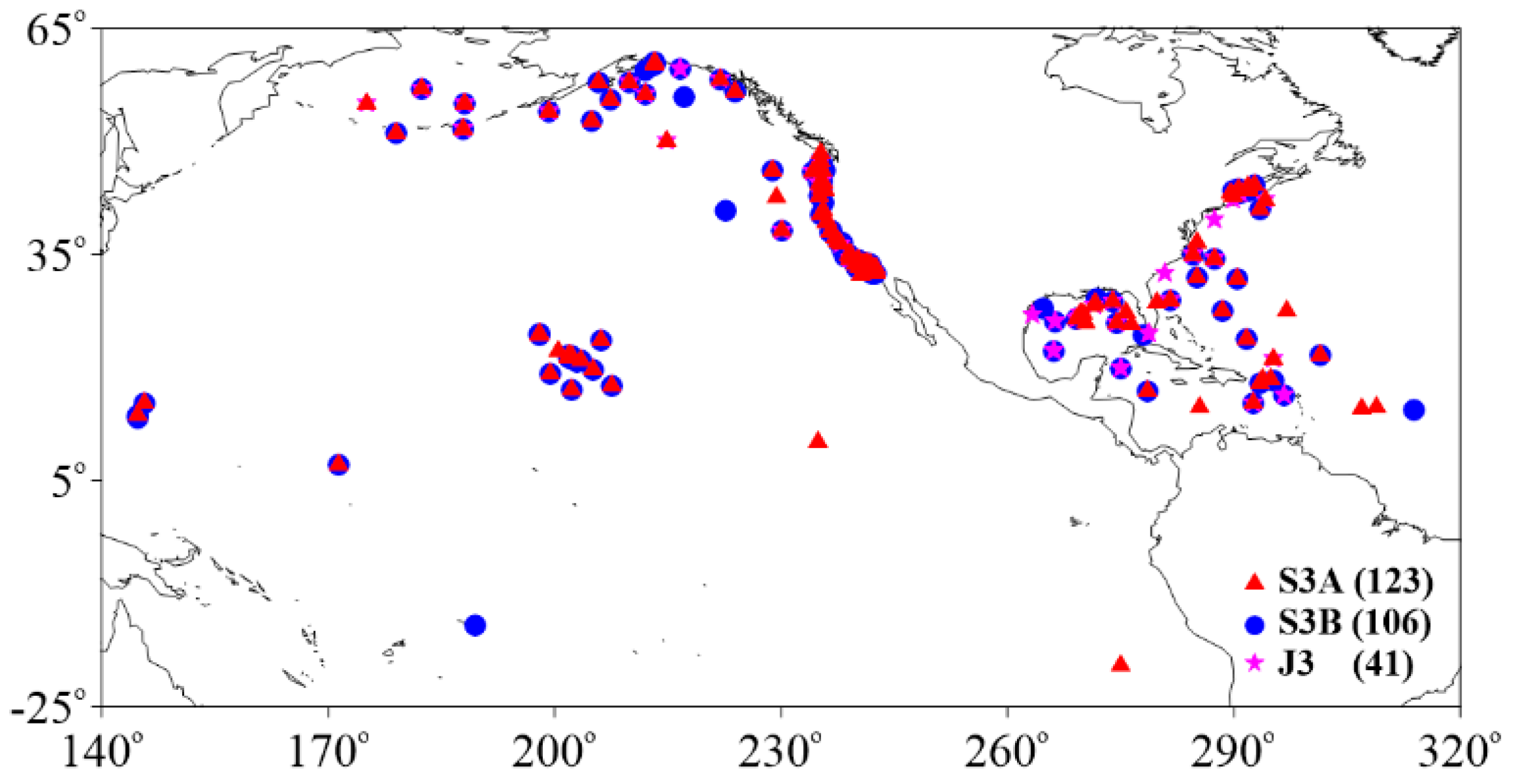
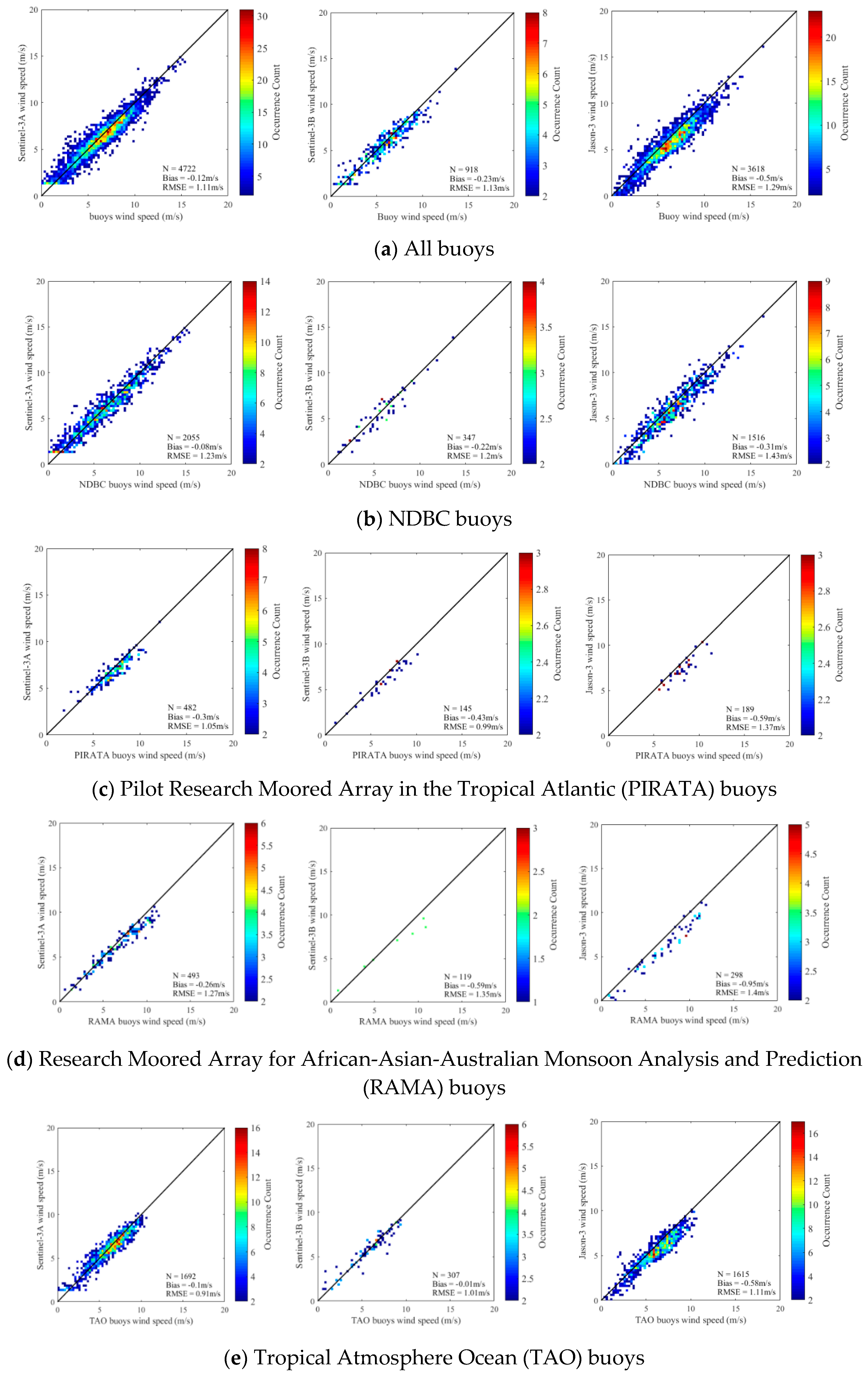
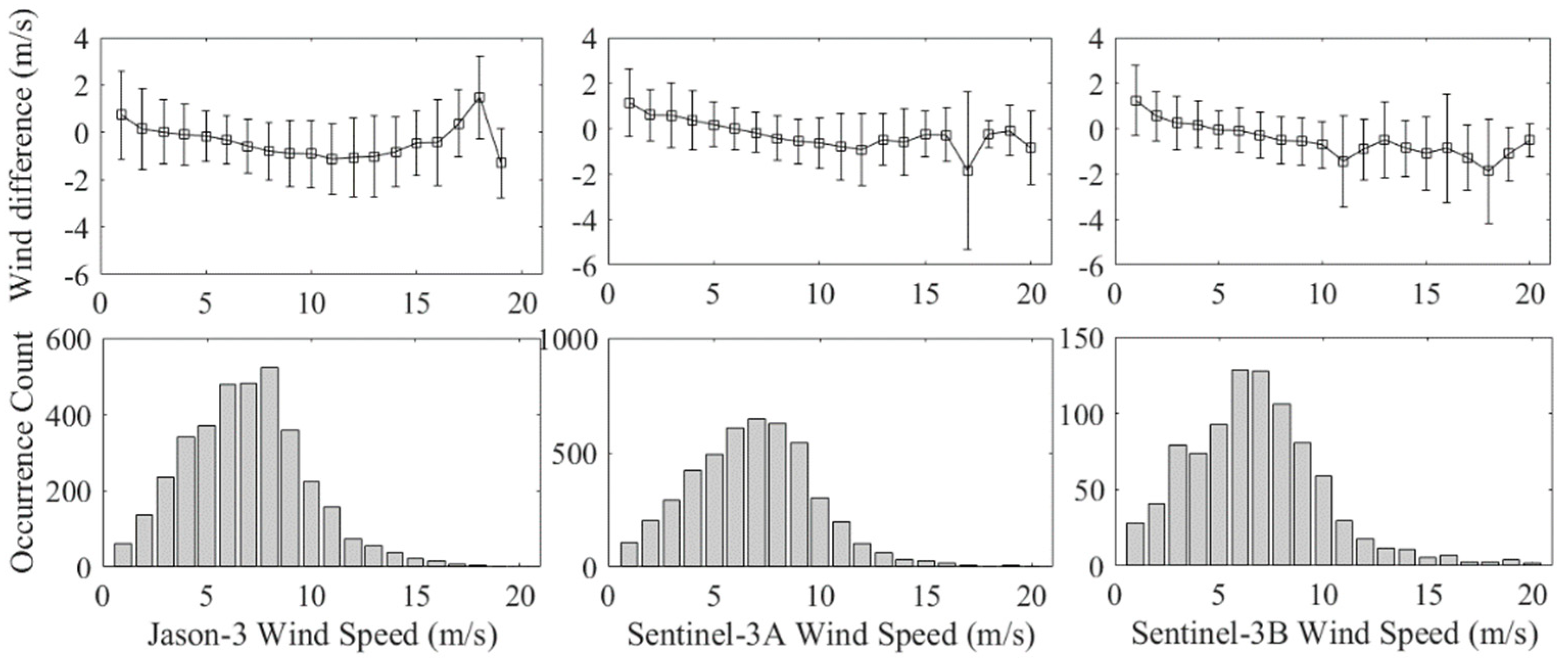
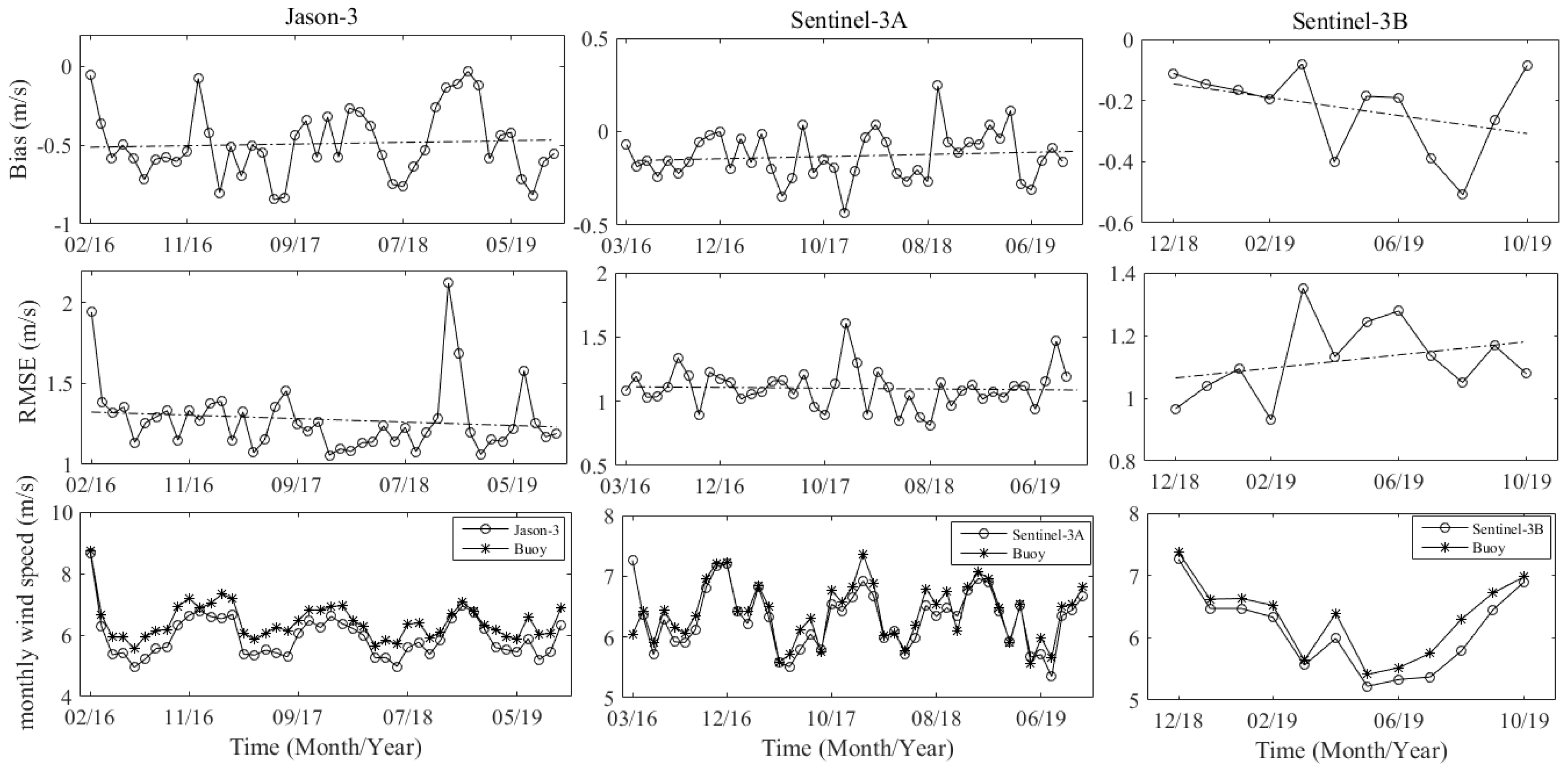
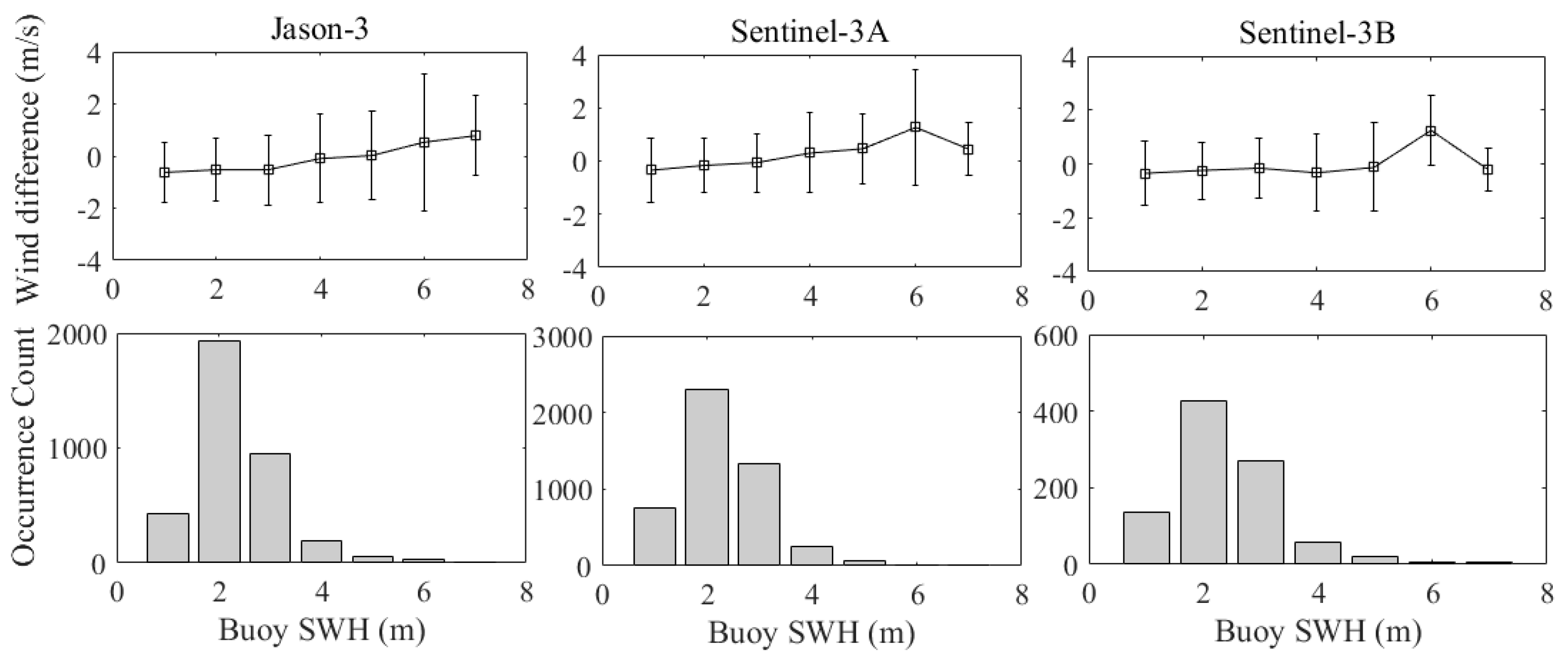

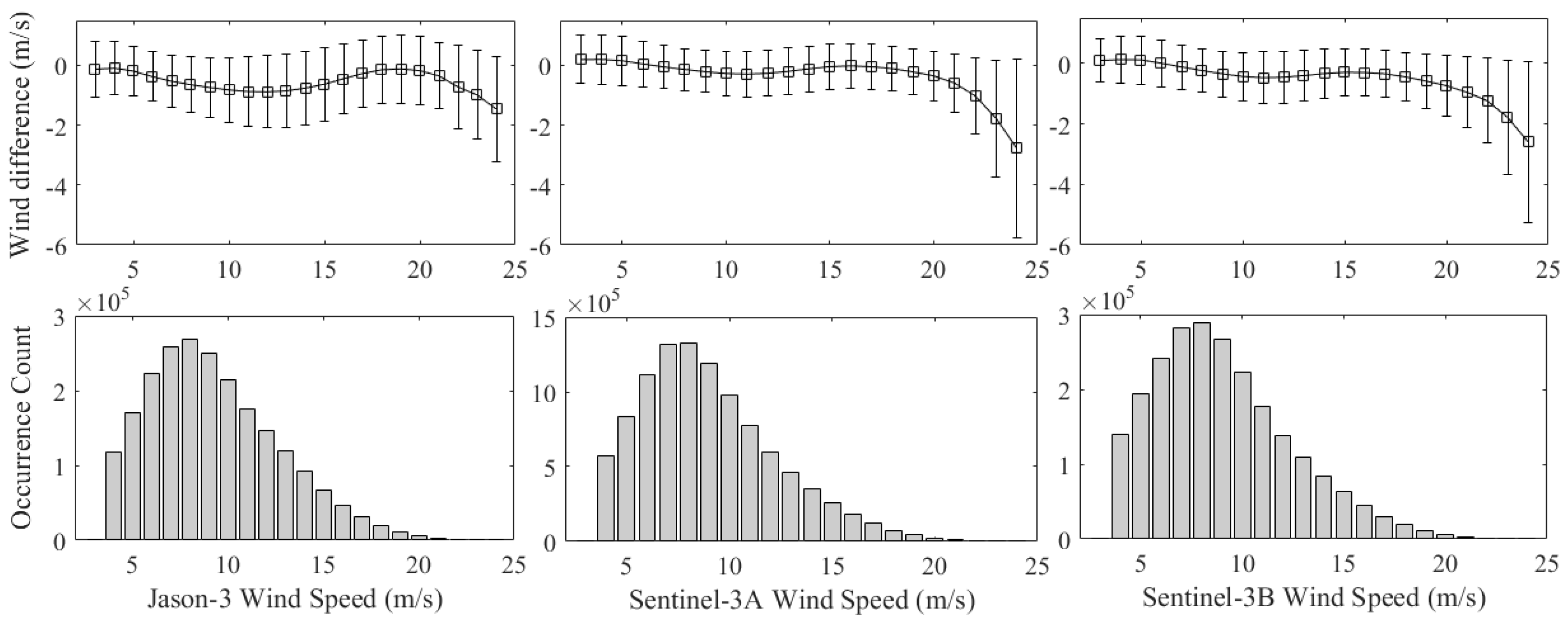
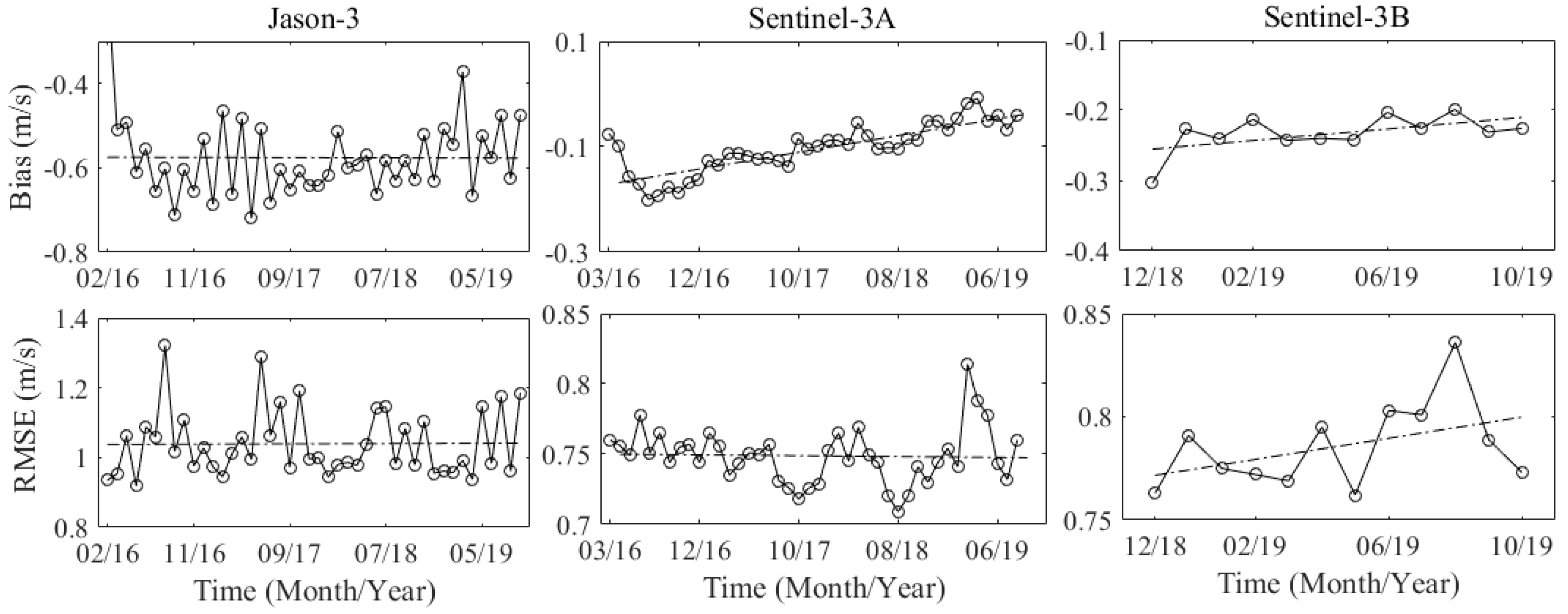

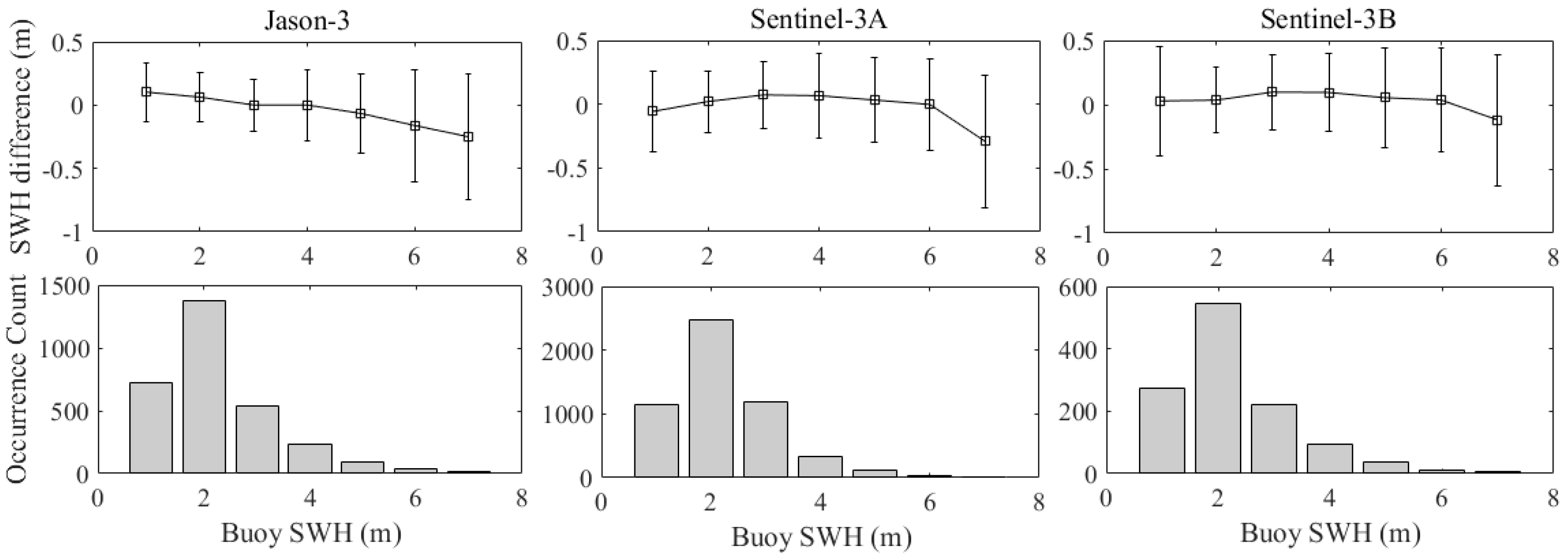
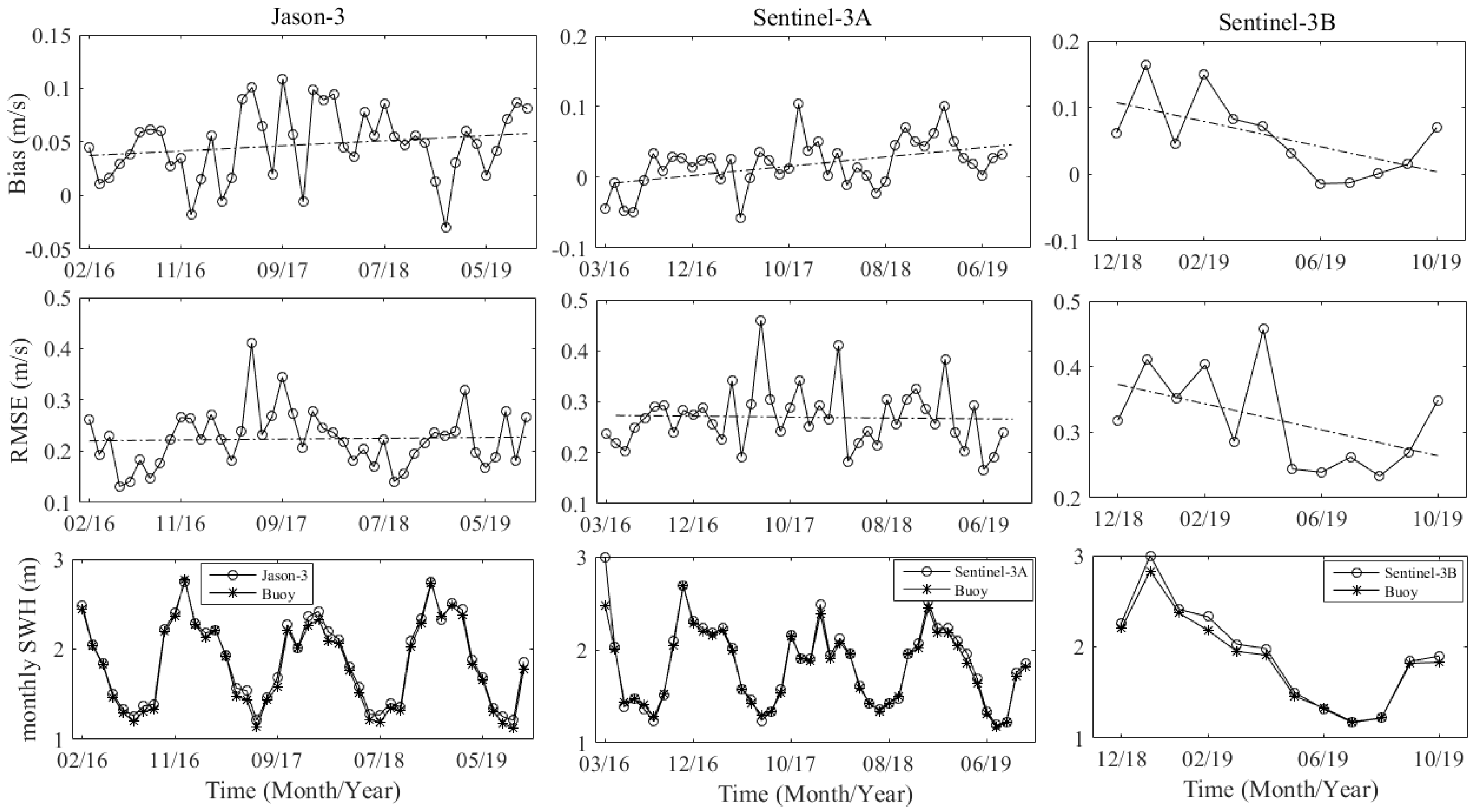
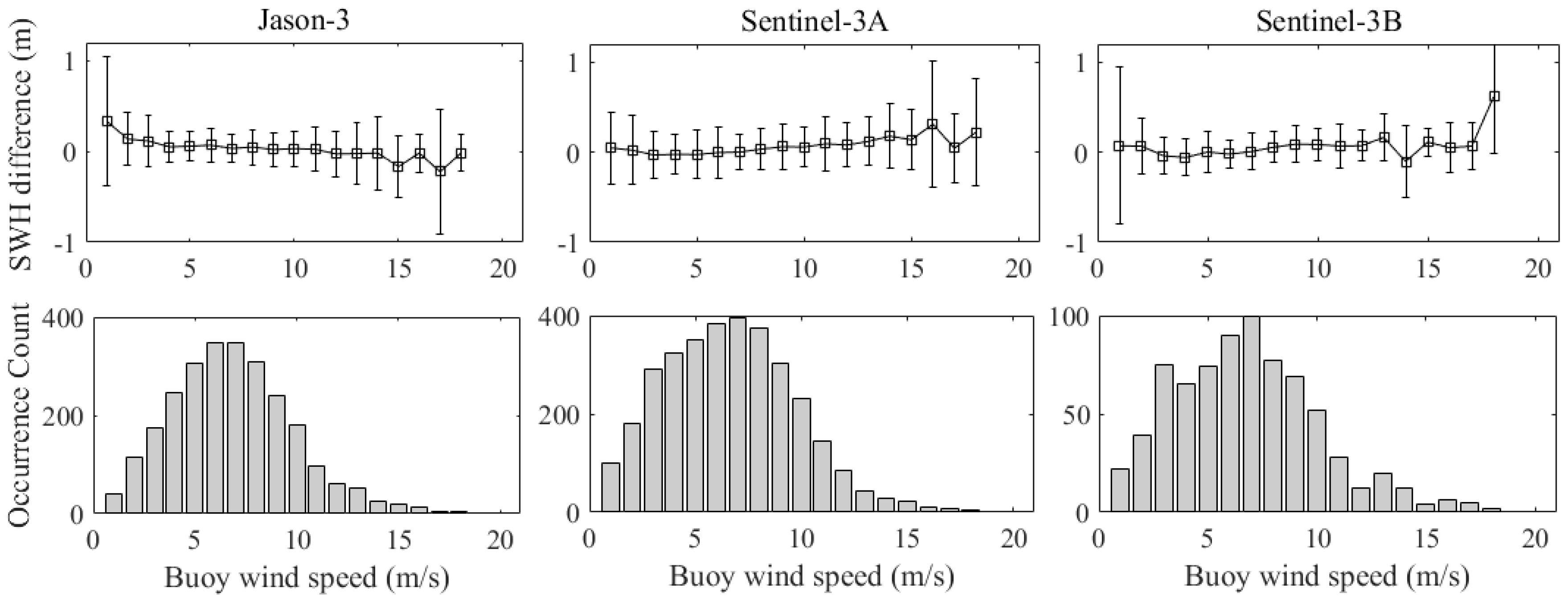
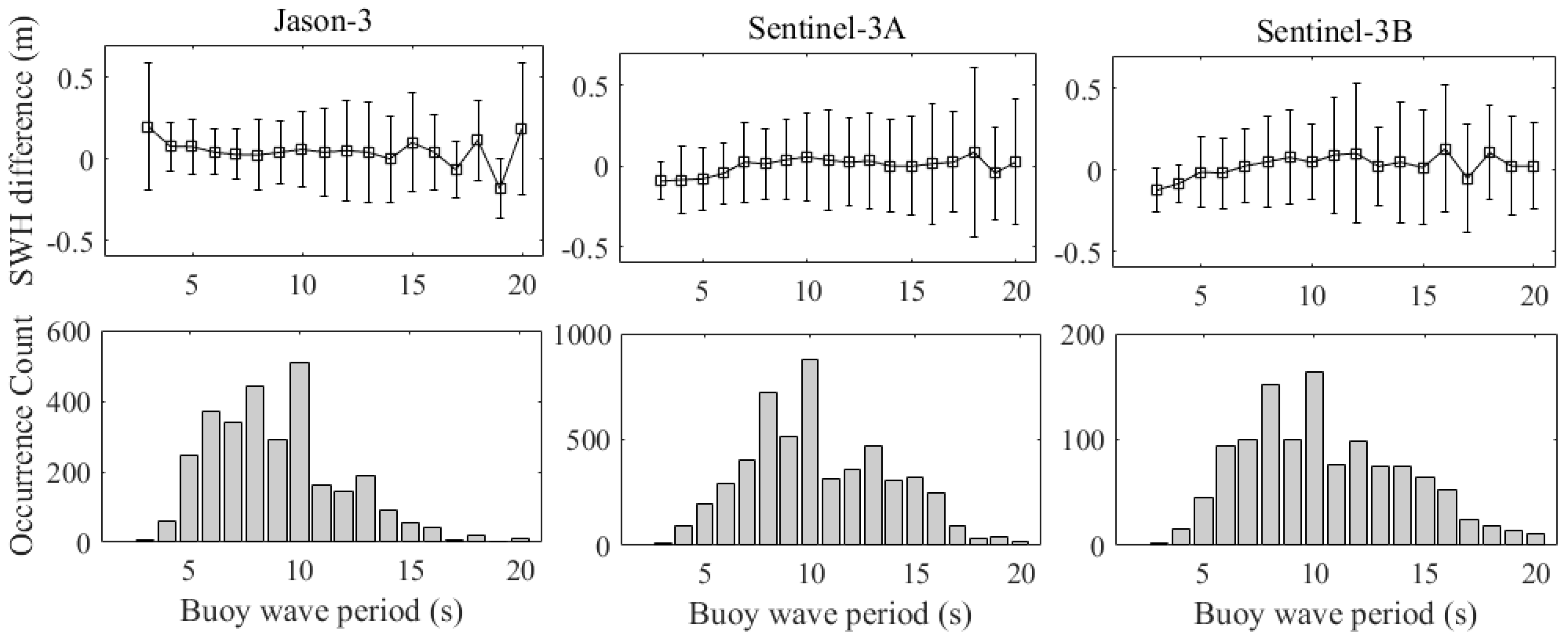
| Buoy | NDBC | TAO | PIRATA | RAMA | ALL |
|---|---|---|---|---|---|
| Number of Collocated Data | 2053 | 1690 | 482 | 493 | 4718 |
| Bias (m/s) | −0.08 | −0.10 | −0.30 | −0.26 | −0.13 |
| RMSE (m/s) | 1.23 | 0.91 | 1.05 | 1.27 | 1.11 |
| R | 0.94 | 0.92 | 0.89 | 0.91 | 0.93 |
| SI | 0.19 | 0.15 | 0.15 | 0.19 | 0.17 |
| Buoy | NDBC | TAO | PIRATA | RAMA | ALL |
|---|---|---|---|---|---|
| Number of Collocated Data | 347 | 307 | 145 | 119 | 918 |
| Bias (m/s) | −0.22 | −0.01 | −0.43 | −0.59 | −0.23 |
| RMSE (m/s) | 1.20 | 1.01 | 0.99 | 1.35 | 1.13 |
| R | 0.96 | 0.91 | 0.94 | 0.93 | 0.94 |
| SI | 0.17 | 0.18 | 0.14 | 0.19 | 0.18 |
| Buoy | NDBC | TAO | PIRATA | RAMA | ALL |
|---|---|---|---|---|---|
| Number of Collocated Data | 1506 | 1608 | 189 | 295 | 3598 |
| Bias (m/s) | −0.31 | −0.58 | −0.59 | −0.95 | −0.50 |
| RMSE (m/s) | 1.43 | 1.10 | 1.37 | 1.40 | 1.29 |
| R | 0.92 | 0.91 | 0.84 | 0.95 | 0.92 |
| SI | 0.21 | 0.16 | 0.16 | 0.15 | 0.19 |
| Altimeter | Sentinel-3A SRAL | Sentinel-3B SRAL | Jason-3 |
|---|---|---|---|
| Number of Collocation | 5345 | 1191 | 3033 |
| Bias (m) | 0.02 | 0.05 | 0.05 |
| RMSE (m) | 0.27 | 0.32 | 0.23 |
| R | 0.97 | 0.96 | 0.98 |
| SI | 0.16 | 0.18 | 0.13 |
© 2020 by the authors. Licensee MDPI, Basel, Switzerland. This article is an open access article distributed under the terms and conditions of the Creative Commons Attribution (CC BY) license (http://creativecommons.org/licenses/by/4.0/).
Share and Cite
Yang, J.; Zhang, J.; Jia, Y.; Fan, C.; Cui, W. Validation of Sentinel-3A/3B and Jason-3 Altimeter Wind Speeds and Significant Wave Heights Using Buoy and ASCAT Data. Remote Sens. 2020, 12, 2079. https://doi.org/10.3390/rs12132079
Yang J, Zhang J, Jia Y, Fan C, Cui W. Validation of Sentinel-3A/3B and Jason-3 Altimeter Wind Speeds and Significant Wave Heights Using Buoy and ASCAT Data. Remote Sensing. 2020; 12(13):2079. https://doi.org/10.3390/rs12132079
Chicago/Turabian StyleYang, Jungang, Jie Zhang, Yongjun Jia, Chenqing Fan, and Wei Cui. 2020. "Validation of Sentinel-3A/3B and Jason-3 Altimeter Wind Speeds and Significant Wave Heights Using Buoy and ASCAT Data" Remote Sensing 12, no. 13: 2079. https://doi.org/10.3390/rs12132079
APA StyleYang, J., Zhang, J., Jia, Y., Fan, C., & Cui, W. (2020). Validation of Sentinel-3A/3B and Jason-3 Altimeter Wind Speeds and Significant Wave Heights Using Buoy and ASCAT Data. Remote Sensing, 12(13), 2079. https://doi.org/10.3390/rs12132079





